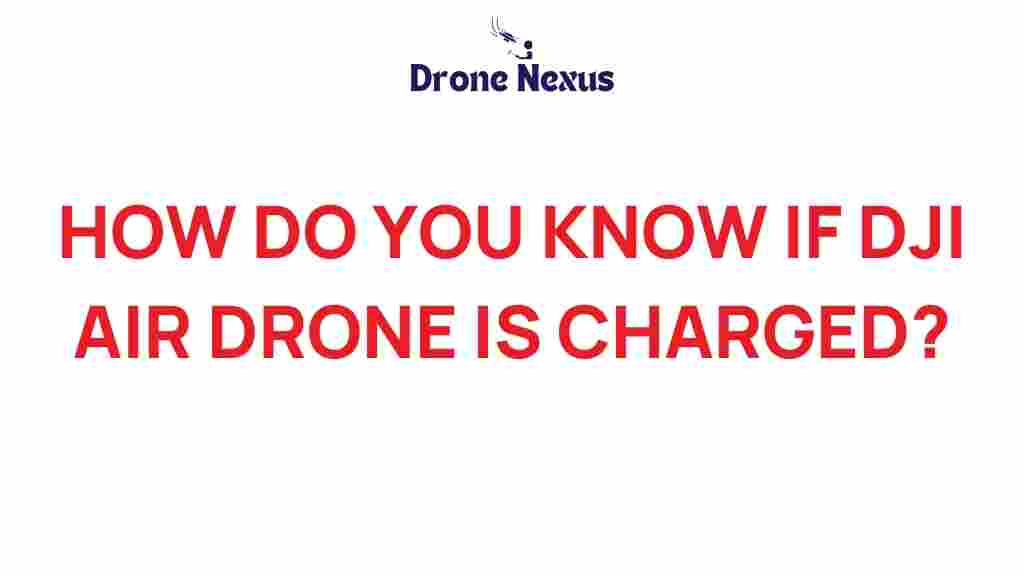Unveiling the Secrets: How to Know If Your DJI Air Drone Is Charged
When it comes to flying your DJI Air drone, one of the most critical factors is ensuring that it is properly charged. Understanding how to check the battery status and knowing the signs of a fully charged battery can help you get the most out of your flying experience. In this article, we will explore the various methods for checking the charge of your DJI Air drone, troubleshooting tips, and essential practices to extend your drone’s battery life.
Understanding Your DJI Air Drone Battery
The DJI Air drone is equipped with a high-performance lithium-polymer battery. Knowing how to manage and check the battery status is crucial for every drone pilot. Here are a few key points about your drone’s battery:
- Battery Type: Most DJI Air drones use Lithium-Polymer (LiPo) batteries, which have specific charging requirements.
- Charging Time: Typically, it takes around one hour to fully charge a DJI Air drone battery.
- Battery Life: Depending on the model, a fully charged battery can provide flight times ranging from 20 to 30 minutes.
How to Check If Your DJI Air Drone Is Charged
There are several methods to confirm if your DJI Air drone is charged and ready for flight. Here’s a step-by-step guide:
Step 1: Inspect the Battery Indicator
Your DJI Air drone battery is equipped with LED indicators that provide real-time information about its charge status. Here’s how to check:
- Locate the battery on your drone.
- Press the button on the battery to activate the LED indicators.
- Observe the lights:
- Four green lights indicate a full charge (75-100%).
- Three green lights mean the battery is about 50-75% charged.
- Two green lights signal a 25-50% charge.
- One red light shows that the battery is critically low (<25%).
Step 2: Use the DJI Fly App
The DJI Fly app provides a comprehensive interface for managing your DJI Air drone, including battery status. Here’s how to use it:
- Connect your smartphone or tablet to the remote controller.
- Launch the DJI Fly app.
- Navigate to the battery status section to see the exact charge percentage and health of the battery.
Step 3: Charging the Battery
If your DJI Air drone battery is low, it’s time to charge it. Follow these steps:
- Ensure that you are using the original DJI charger.
- Connect the charger to a power source.
- Plug the charger into the battery.
- Monitor the LED indicators on the battery to confirm charging status.
Troubleshooting Battery Issues
Even with proper maintenance, battery issues can arise. Here are common problems and their solutions:
Problem 1: Battery Not Charging
If your DJI Air drone battery is not charging, try the following:
- Check the charger for any visible damage.
- Ensure the battery is properly connected to the charger.
- Try using a different power outlet.
- Inspect the battery connectors for dirt or corrosion.
Problem 2: Rapid Battery Drain
If you notice that your battery drains quickly, consider these factors:
- Check if the battery is old or damaged.
- Avoid flying in extreme temperatures, as it can affect battery performance.
- Reduce payload by removing unnecessary attachments.
Problem 3: Inaccurate Battery Level Readings
If the battery status indicators seem inaccurate, perform the following:
- Calibrate the battery using the DJI Fly app.
- Fully charge and discharge the battery to reset its internal software.
Best Practices for DJI Air Drone Battery Care
To extend the life of your DJI Air drone batteries, follow these best practices:
- Regularly Charge: Avoid letting your battery sit for long periods without a charge. It’s best to keep it between 40-60% for storage.
- Temperature Control: Store your batteries in a cool, dry place. Avoid exposing them to extreme temperatures.
- Check Firmware Updates: Ensure your drone and battery firmware are up-to-date for optimal performance.
- Use the Right Charger: Always use the original DJI charger to avoid damaging the battery.
Conclusion
Knowing how to check if your DJI Air drone is charged is essential for an enjoyable flying experience. By understanding the battery indicators, utilizing the DJI Fly app, and following proper charging practices, you can ensure your drone is always ready for action. Additionally, troubleshooting any battery issues promptly can save you time and enhance your flying experience.
For more tips on drone maintenance and flying techniques, check out our comprehensive guide. Remember, a well-maintained DJI Air drone not only provides better performance but also enhances your safety while flying.
For official information and updates, visit the DJI website.
This article is in the category Technology and created by DroneNexus Team
